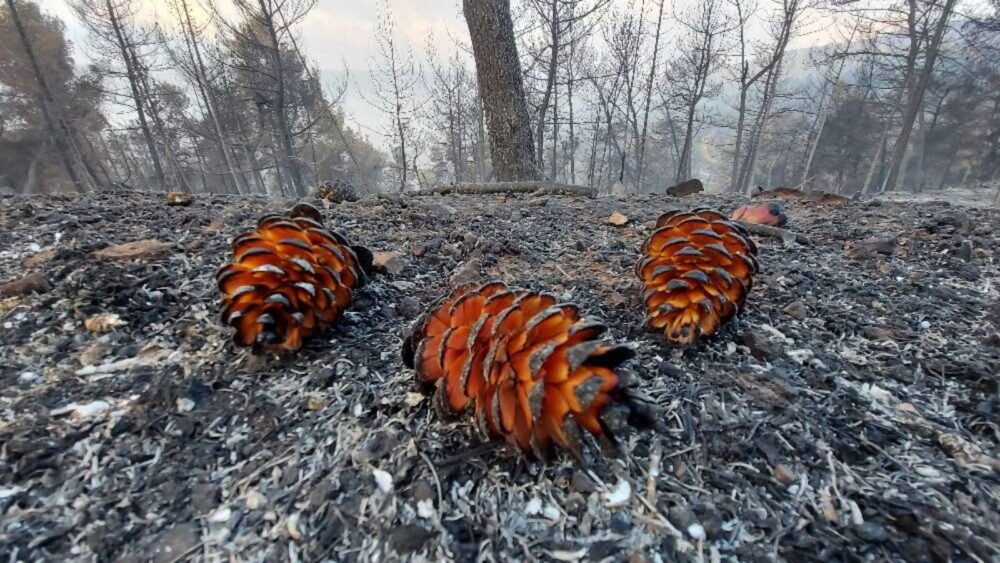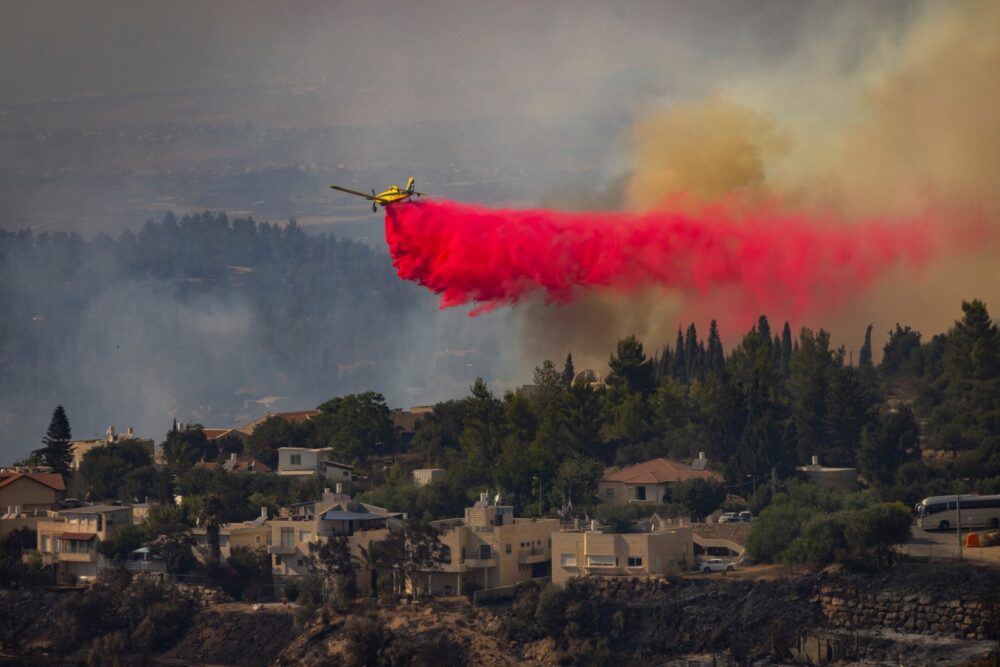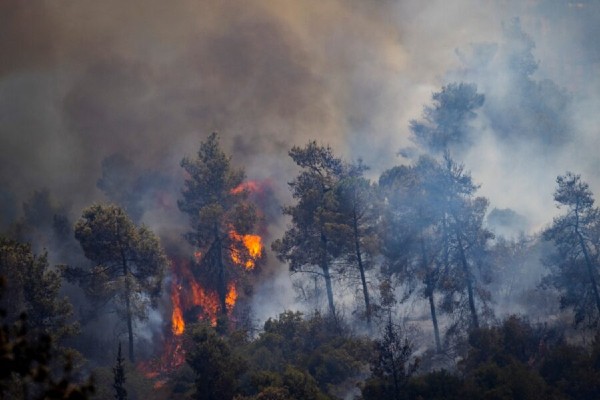Forester Nurit Hibsher says she’s never seen a fire like the one that just blazed through the Jerusalem Hills. It’s got her worried.
By Abigail Klein Leichman, Israel21c
“In the 10 years I have been a forester, I don’t remember fires like this. It’s something really unusual,” admits Nurit Hibsher, head of forestry for the central region at the Keren Kayameth LeIsrael-Jewish National Fund (KKL-JNF).
Hibsher was standing in Sataf Forest, west of Jerusalem less than a week after one of the largest wildfires in Israel’s history ripped through the area, destroying 6,200 acres of woodlands in the Judean Hills.
It took some 1,500 firefighters working for 52 hours to finally put out the blazes, which are reported to have been set deliberately in three different locations.
Sataf is usually an idyllic site with springs and ponds, picnic and play areas, hiking and cycling trails. Pine, cypress, eucalyptus, oak, pistachio, carob and other vegetation grow here, along with grapevines, olive and fig trees planted on agricultural terraces first built 1,000 years ago.
But today, the scene is painful. Smoke lingers in the air, waiting to be washed away by winter rains that are still some way off. Half-green, half-brown trees and shrubs stand in silent testimony to the unpredictable path of the wind-whipped flames and the bravery of those who battled them.
“I was not here during the fires; I wanted to let the firefighters do their job,” says Hibsher, whose job is to control the growth, composition, health and quality of KKL-JNF forests in the central region, including Sataf.
“Now, a few days later, to look at the damage is really hard. I know how much effort we invested here in Sataf for the past 40 years, and in other areas much longer.”
A growing problem
These days, sights like this are becoming frighteningly common around the world. Like Hibsher, there are probably foresters all over the world out examining devastated hillsides.
Huge forest fires in California, Turkey, Australia, Morocco, Canada, Greece and even Siberia dominate the news as hotter, drier temperatures turn living trees into kindling.
In Israel the increasing number of fires every year, and their growing ferocity, have raised questions about the country’s long history of tree planting.
When KKL-JNF began reforesting Israel in 1901, pines were chosen for their rapid growth. But they proved highly flammable, and now the organization favors broadleaved trees and conifers such as cypress.
Hibsher, who was Israel’s first female forester, says the blaze in Sataf blew in from an old natural (not planted) Aleppo pine stand around Beit Meir, a village some eight miles to the west.
“It traveled along the wadi very fast, like a firestorm, and then climbed the mountains. When fire runs that fast you cannot manage it. You have to wait until it gets to a hilly area where it slows and then you can stop it,” Hibsher tells ISRAEL21c.
Hibsher kneels to inspect an Atlantic pistachio striped into thirds by the blaze: green leaves, brown leaves and bare branches.
“This will regenerate from the base of the trunk. In a month or two we’ll see new shoots, even before the rains,” she says optimistically.
Aleppo pines also regenerate, explains Hibsher. “They burn very easily. Their pinecones, however, open up in the extreme heat of the fire and spread seeds. So this will be the next generation.”

Extreme heat causes pinecones to release their seeds. (Amir Balaban, Society for the Protection of Nature in Israel)
Climate change and fires
In previous decades when fires were few and far between, this meant forests had time to regrow before the next blaze. The old Aleppo pine stand that burned in this fire, was regenerated from a powerful fire in the Jerusalem hills in 1995.
“The problem is, with climate change the period between fires is getting shorter,” explains Hibsher, and this is her greatest concern.
Even if this particular fire was caused by arson, forest fires are getting dramatically more frequent and intense across the globe.
It doesn’t take more than a carelessly discarded cigarette or glowing charcoal to start a conflagration. And Israel also suffers fire terrorism, particularly the Gaza border communities under frequent attack by incendiary balloons and kites.
“If we have another fire here in two or three years, we are afraid that the natural process of germination and regeneration will lose out to invasive species that are not a natural part of this ecosystem,” Hibsher says.
She points to a partially scorched acacia shrub as an example.
“During the British Mandate period, the British planted acacias along the coast to stabilize the dunes. We also planted it during the 60s and 70s along the coast. And then we learned it was invasive. It regenerates quickly after a fire and grows everywhere. We will have to put a lot of effort into chemical treatments to keep the acacia from spreading,” says Hibsher.

Firefighters drop retardant chemicals on Moshav Giva’at Ye’arim, Aug. 16, 2021. (Olivier Fitoussi/Flash90)
Natural recovery
In general, KKL-JNF and the Israel Nature & Parks Authority leave burned forests to recover naturally for a few years. Replanting, if necessary, will be done according to a master plan only after that time.
Meanwhile, even the ashes blanketing the forest floor can be beneficial in the process of mineralization and regeneration over the next five years, Hibsher says. “But it will take 20 to 30 years to see tall trees here again.”
Proactive safety measures will be taken in areas where hikers are expected to come.
“We will cut the burned trees after the winter. If we cut them now, we will lose a lot of seedbanks in the ash and the area will have soil erosion. After a fire, the soil is very hydrophobic,” Hibsher explains.
Wildlife perished
The August blaze caused the evacuation of 10 villages in the Jerusalem hills, including a psychiatric hospital, which was evacuated under extreme fire conditions.
Nobody was injured, thanks in part to fast actions by residents and in part to firebreaks created around the villages as a “safety belt” providing access for firefighting vehicles.
Nevertheless, some properties and businesses were ruined, like Micah and Shoshanna Harrari’s handmade wooden harp workshop in Ramat Raziel five miles west of Sataf. Near that same village, an estimated 10,000 laying hens were killed when their coop caught fire.
Birds and large wild animals, such as deer, escaped their burning habitat to surrounding forests, says Hibsher.
Smaller animals had little chance of escape. An unknown number of rodents, lizards, snakes, turtles, fledgling birds and insects perished in Sataf and nearby woods including Mount Tayasim and Mount Eitan.
“It’s very sad,” says Hibsher. “But we think some of the animals, like snakes, were able to hide in holes underground and will come up when they feel it is safe.”
As for the insects that are essential to the ecosystem, “After the first winter you will see the herbaceous vegetation growing and it will bring butterflies and aphids,” she says.
“Once the insects return, we will see the lizards return too. We lost many but there are still plenty out there.”
